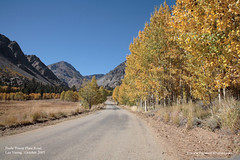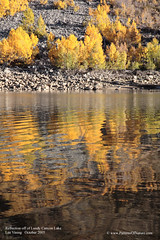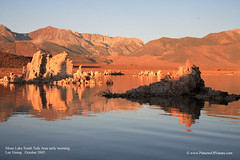
Lee Vining and vicinity (10/12/2005)
Lee Vining was the first stop of my maiden Fall Foliage trip.
 My
first exposure to Lee Vining was at the Poole Power Station Road, which
is located right off of highway 120 east of the Yosemite entrance. It
was here that I found Lee Vining Creek, countless groves of aspen and
willows lining the dirt road or Lee Vining Creek. Surprising to me, the
rate of peaking at this location and elsewhere during my trip was not
uniform. I found half barren trees next to golden trees and green ones.
This would be a blessing since that gives opportunities for folks to visit
for a longer stretch of time than if all the leaves turned at the same
time. Predominantly though, they were in the yellow stage when I was there.
There were campgrounds in this area – Lee Vining II I believe, that
was still open. For my next voyage, I might just camp here or one of the
nearby ones to save driving time.
My
first exposure to Lee Vining was at the Poole Power Station Road, which
is located right off of highway 120 east of the Yosemite entrance. It
was here that I found Lee Vining Creek, countless groves of aspen and
willows lining the dirt road or Lee Vining Creek. Surprising to me, the
rate of peaking at this location and elsewhere during my trip was not
uniform. I found half barren trees next to golden trees and green ones.
This would be a blessing since that gives opportunities for folks to visit
for a longer stretch of time than if all the leaves turned at the same
time. Predominantly though, they were in the yellow stage when I was there.
There were campgrounds in this area – Lee Vining II I believe, that
was still open. For my next voyage, I might just camp here or one of the
nearby ones to save driving time.
 After
an hour or so at this road, I drove to Lee Vining to check in the only
motel I found through AAA that still had one vacancy! I did not anticipate
there’d be so many leaf-peepers in October. I subsequently found
out that there were other motels in the town. They just did not advertise
with AAA. In speaking with the motel owner and subsequently with the local
Visitor Center, I decided to check out Lundy Canyon that afternoon, to
follow by Mono Lake the following morning to check out the tufas. For
those who want to know, tufas are strangely shaped formations made of
salty lake water (carbonates) plus the calcium from spring water (calcium
carbonate).
After
an hour or so at this road, I drove to Lee Vining to check in the only
motel I found through AAA that still had one vacancy! I did not anticipate
there’d be so many leaf-peepers in October. I subsequently found
out that there were other motels in the town. They just did not advertise
with AAA. In speaking with the motel owner and subsequently with the local
Visitor Center, I decided to check out Lundy Canyon that afternoon, to
follow by Mono Lake the following morning to check out the tufas. For
those who want to know, tufas are strangely shaped formations made of
salty lake water (carbonates) plus the calcium from spring water (calcium
carbonate).
Lundy Canyon was relatively easy to get to. There was Mill creek running alongside the road for much of the way. The motel owner told me of some beaver ponds without specific instructions, and I did not know enough to press. So I wound up at the lake without finding the ponds. I found a beautiful setting of a lake bordered by mountain and golden foliage at the hillside. There were fishermen on the shore or on boats. The scenery was much nicer than what I was able to capture on “film”. As the sun set over the mountain, I began to head back down, but made a stop at a picnic area close to the lake. This was a good decision because I found a nice location of fallen trunks blocking the path of the creek, thus creating a small “beaver pond” for me, completed with leaves jamming at the log, idle water at the top and a small waterfall below. Low-light pictures taken here were my favorites of the Lee Vining stop.
 It
was getting dark as I got down to the highway. I stopped by a couple of
viewpoints to Mono Lake and captured a few more pictures. Hindsight, I
should have taken the time to drive around to get a better sense. Learning
from this and when it was totally dark, I made another crazy decision
to drive on to the South Tufa area to check it out before heading out
to it the next morning. Well, the South Tufa area was not visible to me
that night from the parking lot. So, I ventured on the trail to reach
it, not knowing how far I’d have to walk or hike. Fortunately, it
was not too far of a walk to reach these grotesque-looking natural sculptures.
Amazingly, I found 2 people still lingering there taking night time pictures.
I also tried it with fair results. After a few long exposures as my fingers
getting numb, I figured out that I was not adequately dressed for the
cold night there and headed back out. Then long before dawn, I somehow
found the strength to get up and drove to the place again- Having been
there before certainly made this much easier. And I was smart enough to
bring gloves this time (and to my less-than-nice satisfaction –
found others who complained to me that they were not adequately dressed.)
I suppose the crazy idea the previous night had some benefits. I was at
the South Tufa area through the early morning sun to capture many moods
of the tufas, Mono Lake and the Sierra Mountains in the background. Having
seen the lake and tufas up close, I plan to come back to this area another
time to capture other moments and to learn more about the region. For
example, I learned that Mono Lake is one of the most ancient lakes in
North America at more than a million years old. It’s amazing to
me that this million-year-old lake water level decreased substantially
for a number of decades recently thanks to the diversion of water to the
city of Los Angeles (where I lived for several years). Fortunately, that
seems to have stabilized at this time. I also learned that this lake is
a major stop over point for bird migration, and that there are photo workshops
at reasonable price.
It
was getting dark as I got down to the highway. I stopped by a couple of
viewpoints to Mono Lake and captured a few more pictures. Hindsight, I
should have taken the time to drive around to get a better sense. Learning
from this and when it was totally dark, I made another crazy decision
to drive on to the South Tufa area to check it out before heading out
to it the next morning. Well, the South Tufa area was not visible to me
that night from the parking lot. So, I ventured on the trail to reach
it, not knowing how far I’d have to walk or hike. Fortunately, it
was not too far of a walk to reach these grotesque-looking natural sculptures.
Amazingly, I found 2 people still lingering there taking night time pictures.
I also tried it with fair results. After a few long exposures as my fingers
getting numb, I figured out that I was not adequately dressed for the
cold night there and headed back out. Then long before dawn, I somehow
found the strength to get up and drove to the place again- Having been
there before certainly made this much easier. And I was smart enough to
bring gloves this time (and to my less-than-nice satisfaction –
found others who complained to me that they were not adequately dressed.)
I suppose the crazy idea the previous night had some benefits. I was at
the South Tufa area through the early morning sun to capture many moods
of the tufas, Mono Lake and the Sierra Mountains in the background. Having
seen the lake and tufas up close, I plan to come back to this area another
time to capture other moments and to learn more about the region. For
example, I learned that Mono Lake is one of the most ancient lakes in
North America at more than a million years old. It’s amazing to
me that this million-year-old lake water level decreased substantially
for a number of decades recently thanks to the diversion of water to the
city of Los Angeles (where I lived for several years). Fortunately, that
seems to have stabilized at this time. I also learned that this lake is
a major stop over point for bird migration, and that there are photo workshops
at reasonable price.
After the sun reaches the lake level, everyone headed out for other things. For me, it was time to head to the famed June Lake Loop.
Some pictures are posted HERE.
Home About Us Friends Family Copyright
Last updated: October 17, 2010